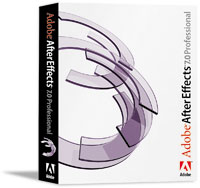Adobe After Effects 7


The industry standard for motion graphics and visual effects
 Adobe After Effects 7 by Adobe Systems Incorporated
Adobe After Effects 7 by Adobe Systems Incorporated
Every time Adobe releases a new version of After Effects, there comes the inevitable question: “Should I upgrade?” Hmm, let’s see…
The first thing that strikes you when you open After Effects 7 (AE 7) is that it no longer looks like After Effects! The entire interface has been redesigned to be more fluid and integrated to suit your workflow and to align with the other programs in the new Adobe Production Studio. The windows and palettes (now called panels) are organized into scalable, sliding frames which, when expanded, force the others to contract. This allows completely customizable workspaces to be created and saved. Panels can be docked in any order, and my absolute favorite feature is to use the Tilde key! Hover your mouse over any panel, press the ~ key (above the Tab key), and that panel expands to fit your entire screen. It’s extremely handy for quickly zooming in on Comps and Timelines when detail is needed!
But it’s not just about looks. The Comp Settings now contain more presets for the multitude of HD and HDTV sizes. The ability to import (and export) 32-bit TIFF and Photoshop files (and audio) opens up the doors to a higher quality than ever before. With many of the program’s effects also 32-bit compatible, you have the power to match the behavior of color and light in the real world with amazing accuracy.
The incredible option to import images from Camera Raw (even as a sequence!) allows you to go from shoot to composite in a straight line—with full control over exposure, temperature, shadows, and detail—via the same Camera Raw dialog as Photoshop CS2. Even after being imported and used, the image can be updated at any time.
The built-in capability to export Flash Video (FLV) changes the way you think about Web design. The ability to retain transparency and alpha channel information (even motion blurred edges) when exporting FLV files for inclusion in a Flash website is astounding, and one I’ve used countless times already with great success.
The new Graph Editor gives you keyframe and velocity control like never before, a feature that has long been lacking from AE. You can edit any number of properties simultaneously and adjust their keyframe values and positions over time. The ability to adjust multiple bézier curves at once, and even use shortcuts to taper keyframe values up or down, makes previously difficult animation much easier to achieve.
The inclusion of Adobe Bridge is a bonus, especially with the greatly expanded selection of animation and behavior presets that come with AE 7. Browsing through presets with full previews is cool, but double-clicking a preset in Bridge and having it applied automatically to your selected layer(s) in AE is a huge timesaver. There’s also a large selection of cool DVD motion menu project templates, most of which were created by yours truly—me!
After Effects now works much more seamlessly with the other Production Studio programs via the Adobe Dynamic Link, which allows you to import and preview AE comps in Premiere and Encore, without rendering first. The downside, of course, is that it’s a Windows-only feature.
The upgrade to OpenGL version 2 is huge for 3D work. With the right video card, many more features are rendered in real-time when zipping around the Comp in 3D space, such as blend modes, track mattes, adjustment layers, and motion blur. Again, it’s a great timesaver but the hardware is needed to support it.
So, should you upgrade? I think you already know the answer. Enjoy!
PRICE:$999 (Professional); $699 (Standard)
FROM: Adobe Systems Incorporated
PHONE: 888-724-4508
WEB: www.adobe.com
FOR: Mac and Windows
RATING: 4 1/2
